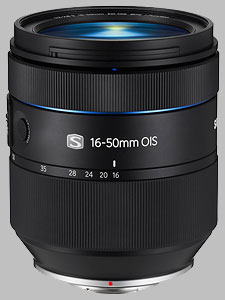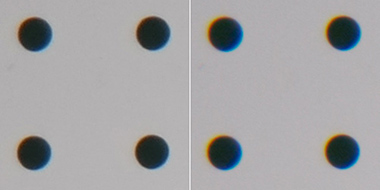| 16-50mm | |
|---|---|

|
|
Your purchases support this site
Buy the Samsung 16-50mm f/2-2.8 S ED OIS NX
SLRgear Review
December 3, 2014
by Andrew Alexander
Samsung slowly continues to expand its lineup of interchangeable lenses with the addition of the 16-50mm ƒ/2-2.8 S ED OIS NX. First displayed at CES 2014, the lens is now available on its own or as part of a NX1 camera kit.
The 16-50mm isn't a ''constant'' lens, in that as you increase the focal length, the maximum aperture size decreases (the minimum aperture of f/22 stays constant). Unlike a typical variable-aperture zoom lens, the 16-50mm is uniquely fast, ranging from f/2 down to just f/2.8. That's still as fast as most equivalent lenses at the telephoto end, but faster at the wide end by one stop. The following table reflects the change in aperture size with focal length:
| Focal Length (mm) | 16 | 20 | 24 | 28 | 35 | 50 |
| Max. aperture | ƒ/2 | ƒ/2.2 | ƒ/2.5 | ƒ/2.5 | ƒ/2.8 | ƒ/2.8 |
| Min. aperture | ƒ/22 | |||||
The Samsung 16-50mm ƒ/2-2.8 ships with a petal-shaped lens hood, takes 72mm filters, and is available now for around $1,100.
Sharpness
At the time of writing, the Samsung 16-50mm ƒ/2-2.8 is one of Samsung's sharpest lenses. Its wide aperture setting of ƒ/2 makes it quite attractive, and happily, it produces very sharp images at this setting. Our copy of the lens shows very slight de-centering, with the lower part of the image sharper than the upper.
When used at 16mm and ƒ/2, we note excellent sharpness in the central region of the frame, with some light corner softness. Increased sharpness is possible by stopping down the lens; at ƒ/4, it's about as sharp as it will get at 16mm, the corners having improved dramatically, but we're not getting images which are tack-sharp across the frame.
Other focal lengths provide a similar experience. The mid-range of focal lengths, 28mm, produces the most corner softness compared to the center of the frame (at ƒ/4) - albeit this is in part due to the de-centered nature of the lens we'd tested. Curiously, stopping the lens down at this focal length to ƒ/5.6 produces almost tack-sharp images.
On the far side of the focal lengths - above 28mm - it's a bit soft in the corners below ƒ/5.6, but then at that aperture setting, you get as close to tack-sharp images as you can.
Diffraction limiting sets in at ƒ/11, but you won't notice any real impact on image sharpness until ƒ/16 or ƒ/22, where we note generalized softness across the frame.
Chromatic Aberration
We had some issues with testing chromatic aberration in the lab, which was a real-world examination of how reliant camera makers have become on correcting lens faults in the camera, rather than in the lens.
To illustrate the amount of post-processing that is performed on JPEG images in-camera to remove chromatic aberration, we have produced two test result pages for CA - one from RAW images, which don't have CA reduction applied, and one from JPEG images, which do.
 | |
| CA corrected in JPEG | CA uncorrected from RAW |
That's some significant orange-blue shift. It's one thing to say that the camera can remove color shifts which are presented by chromatic aberration, but this doesn't remove the resulting reduction in clarity where those shifts occur.
Looking at the numbers, the Samsung 16-50mm produces some of the worst chromatic aberration we've seen; notably, at the 16mm end. Happily, this is really only noticeable in the corners of images; throughout the image, it's only slightly noticeable. As well, it's more prevalent in images shot with wider apertures (ƒ/2-2.8) and its reduced as you stop down the lens.
Shading (''Vignetting'')
There isn't much of a story here regarding corner shading - it's the corners are a quarter-stop darker (or less) than the center, regardless of the focal length and aperture you shoot with.
Distortion
As you'd expect with any wide-angle zoom lens, distortion is present in images shot with the Samsung 16-50mm ƒ/2-2.8. However, it's better than you might expect, potentially aided by in-camera JPEG processing. At the wide end we note only +0.5% barrel distortion in the corners; at the telephoto end we see -0.25% pincushion distortion. And there's a nice area of no distortion between 24mm and 28mm.
Autofocus Operation
The Samsung 16-50mm ƒ/2-2.8 uses a stepping motor for silent AF, which is great for video. Their stepping motor system is named the Ultra-Precise Stepping Motor (UPSM), and it focuses quickly, going through its entire focusing range in less than one second. Point to point focusing is very quick. The front element accepts 72mm filters, and will not rotate during focus operations, making life just that little bit easier for polarizer users.
Macro
The lens offers just 0.19x magnification at its minimum close-focusing distance of 30cm (around a foot), making it a relatively poor choice for macro work.
Build Quality and Handling
The Samsung 16-50mm ƒ/2-2.8 S ED OIS NX is a beefy lens to put on any of the NX camera bodies. It's significantly heavier than the 18-55mm kit lens - 622 grams instead of the kit lens' 204 - but in relative terms, that's not all that heavy, given the lens' metal construction. The lens features a smooth black finish. It's a complex lens, composed of 18 elements in 12 groups with 3 Aspherical elements, 2 ED elements and 2 XHR elements; the nine-bladed circular aperture diaphragm helps create smooth, pleasing background blur.
Samsung has embraced a distinctly new-world attitude towards photography in its lenses, featuring only focal length markings: the lens and has no distance scale or depth-of-field markings. The lens takes 72mm filters.
In addition to the focus and zoom rings there are three control switches. The first switch activates or deactivates autofocus, and the second switch enables or disables image stabilization. The third is the I-Function button, which operates the camera's I-Function, well, function. The I-Function system allows you to adjust all sorts of camera exposure and image quality settings. It's a very handy feature, especially when paired with sleeker cameras like the Samsung NX300 that do away with a front control dial.
The focus ring is only about a half-inch wide with raised plastic ribs. The ring turns forever, without stops to let you know you've reached infinity or close-focusing distance. The lens features internal focusing, so there's no change in lens size during focusing.
The zoom ring is about an inch wide, with deep rubber ribs. It offers about eighty degrees of turning radius. As the lens is zoomed from 16mm to 50mm, it extends its length, from 3 3/4" to 4 1/2" when fully zoomed in to 50mm.
Finally, Samsung has included Optical Image Stabilization in this lens, which can be a welcome alternative to lugging around a tripod. Samsung's marketing materials don't specify how effective its OIS system is, but our testing shows that it can confidently produce around two and a half stops of hand-holding stability at the wide end, and even better performance at telephoto. Check out our IS Test tab above for more detail.
Alternatives
At the time of writing, no third parties produce lenses in the Samsung lens mount, so your alternatives are limited to those produced by Samsung.
Samsung 18-55mm III ƒ/3.5-5.6 OIS NX ~$220
Most Samsung NX camera users already have this lens, so it's here as a reference point for those considering the 16-50mm as an upgrade. In general, the 16-50mm is superior, except the 18-55mm seems to offer better performance regarding chromatic aberration.
Samsung 16-50mm ƒ/3.5-5.6 Power Zoom ED OIS NX ~$350
We haven't yet tested this lens, but with its power zoom function it's considerably more useful for creating movies.
Conclusion
In general, there's no question that the Samsung 16-50mm ƒ/2-2.8 is an improvement over the 18-55mm kit lens; it's sharper, offers a wider aperture, and shows less distortion. Our concerns about chromatic aberration are less important now that cameras correct it in the creation of JPEGs, and RAW processing software can also correct for it. It's just worth noting that if you shoot RAW at 16mm and ƒ/2, you will probably be looking at doing some post work to correct these color shifts.
Otherwise, the lens handles well on the camera (if perhaps a bit bulky on our small NX300) and produces excellent images.
Product Photos
 |
 |
 |
 |
 |
 |
Sample Photos
Click here for Real-world Gallery Images on our Flickr page!
The VFA target should give you a good idea of sharpness in the center and corners, as well as some idea of the extent of barrel or pincushion distortion and chromatic aberration, while the Still Life subject may help in judging contrast and color. We shoot both images using the default JPEG settings and manual white balance of our test bodies, so the images should be quite consistent from lens to lens.
As appropriate, we shoot these with both full-frame and sub-frame bodies, at a range of focal lengths, and at both maximum aperture and ƒ/8. For the ''VFA'' target (the viewfinder accuracy target from Imaging Resource), we also provide sample crops from the center and upper-left corner of each shot, so you can quickly get a sense of relative sharpness, without having to download and inspect the full-res images. To avoid space limitations with the layout of our review pages, indexes to the test shots launch in separate windows.
Samsung 16-50mm f/2-2.8 S ED OIS NX
Your purchases support this site
Samsung NX - Black
Samsung 16-50mm f/2-2.8 S ED OIS NX User Reviews
The Samsung 16-50mm f/2-2.8 S ED OIS NX doesn't have any user reviews yet!





